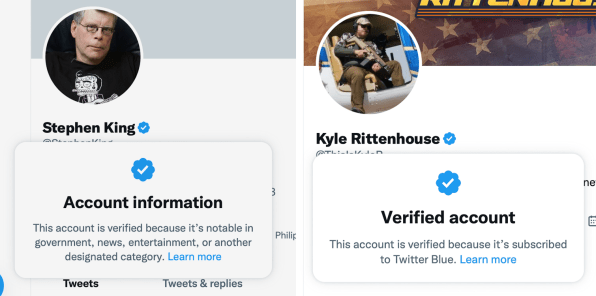Twitter blue check mark: Here’s how to see who paid for their verified badge
As we enter the third chaotic week since Elon Musk’s takeover of Twitter, nothing has become more contentious on the platform than the blue “verified” badge, which Musk had promised would become a commodity that people could pay for via the Twitter Blue subscription service.
And in a move likely to draw even more ire, Twitter users can now see who has paid for their blue badge and who hasn’t.
Twitter blue badge verification: a brief history
Historically, the blue badge (aka the blue check mark) served an important function: It told you that the account was actually the person or organization it claimed to be. This is why the blue badge was also known as the “verified badge,” because Twitter actually verified the people or organizations behind it. (Individuals would need to submit government-issued IDs to prove their identity, for example.)
Since the blue verified badge was limited to notable users—politicians, journalists, accomplished creatives, business persons, etc—having a blue badge quickly became a social media status symbol. But the blue badge also drew lots of hate, especially against journalists who had it. To those condemning the blue badge, many argued that its exclusivity diminished some viewpoints while elevating the opinions of those in, particularly, left-leaning media (although plenty in right-wing media had the blue badge as well).
The blue verification badge loses its meaning in the Musk era
Enter Elon Musk, the self-declared free speech absolutist. Musk’s primary focus since acquiring Twitter has been opening the blue badge to anyone who wants it—or, at least, is willing to pay $8 a month to a billionaire. But in opening the blue badge to anyone, the symbol has lost its former cachet, because now anyone can get the blue badge by subscribing to Twitter Blue, not because of the position they hold or their accomplishments.
But the blue badge has also lost its “verification” purpose, too. Those who get the blue badge by signing up for Twitter Blue don’t actually have their identities verified by Twitter. This has led to concern from governing institutions, annoyance from previously verified investors like Mark Cuban, and mockery from people who suspect that only the vain would pay a billionaire eight bucks a month for some blue pixels.
Twitter lets you see who’s paid for a blue check mark (for now)
One thing people buying blue badges through the Twitter Blue service should be aware of is that anyone can see you’ve purchased your badge instead of previously being verified by Twitter when the blue badge meant something.
Here’s how to see who has (and hasn’t) paid for the Twitter blue badge:
- Go to any Twitter profile that has a blue badge. You will see the blue badge next to their name.
- Click on the blue badge.
In the popup window that appears you’ll see one of two messages:
- “This account is verified because it’s subscribed to Twitter Blue.” (This means the Twitter user is paying $8 a month for the blue badge.)
- “This account is verified because it’s notable in government, news, entertainment, or another designated category.” (This means the Twitter user was previously verified because they were a notable figure in one of the designated categories.)
For example, Stephen King is verified because he is one of the most successful novelists the world has ever seen. Kyle Rittenhouse, on the other hand, is now verified because he pays a monthly subscription for Twitter Blue.

Twitter’s feature, which essentially squeals on users who paid for verification, is likely to cause more mockery. Indeed, there’s already a GitHub project called “eight-dollars” that allows you to turn paid blue check marks into dollar signs via a browser extension.
This mockery may prompt Musk to do away with the distinctive information windows that appear when a blue badge is clicked on. But as it stands now, there are still different statuses on Twitter, and the website clearly shows it.
(98)


